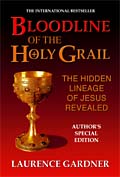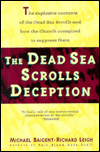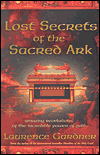The Cult of Mithra
 The discovery of the
precession of the equinoxes led Stoics in Tarsus to
"hypothesize the existence of a new divinity responsible for
this new cosmic phenomenon, a divinity capable of moving the
structure of the entire cosmos and thus a divinity of great
power." Mithras was this deity, and he is seen killing the bull
because the act symbolizes the ending of the cosmic age in
which Mithraism was born. The festival of Mithras' birth was
December 25th, the winter solstice, and the rebirth of the sun's
light.
The discovery of the
precession of the equinoxes led Stoics in Tarsus to
"hypothesize the existence of a new divinity responsible for
this new cosmic phenomenon, a divinity capable of moving the
structure of the entire cosmos and thus a divinity of great
power." Mithras was this deity, and he is seen killing the bull
because the act symbolizes the ending of the cosmic age in
which Mithraism was born. The festival of Mithras' birth was
December 25th, the winter solstice, and the rebirth of the sun's
light.
(Quote)I would suggest that the awe-inspiring quality of Plato's vision of what is beyond the outermost boundary of the cosmos also lies behind the appeal of Mithras as a divine being whose proper domain is outside of the universe. As the text from Plato shows, the establishment by ancient astronomers of the sphere of the stars as the absolute boundary of the cosmos only encouraged the human imagination to project itself beyond that boundary in an exhilarating leap into an infinite mystery. There beyond the cosmos dwelled the ultimate divine forces, and Mithras's ability to move the entire universe made him one with those forces.
Here in the end we may sense a profound kinship between Mithraism and Christianity. For early Christianity
also contained at its core an ideology of cosmic transcendence. Nowhere is this better expressed than in the opening
of the earliest gospel, Mark. There, at the beginning of the foundation story of Christianity, we find Jesus, at the moment
of his baptism, having a vision of "the heavens torn open." Just as Mithras is revealed as a being from beyond the
universe capable of altering the cosmic spheres, so here we find Jesus linked with a rupture of the heavens, an
opening into the numinous realms beyond the furthest cosmic boundaries. Perhaps, then, the figures of Jesus
and Mithras are to some extent both manifestations of a single deep longing in the human spirit for a sense of
contact with the ultimate mystery.
Mithra, extensive research
Excerpts from reviews of
The Origins of the Mithraic Mysteries:
Cosmology and Salvation in the Ancient World
by David Ulansey
(Oxford University Press, 1989; revised paperback, 1991)
Roman Birthday of the Unconquered Sun was identified with Mithra, one of several Persian yazatas (minor deities) under Ahura Mazda in the Zoroastrian pantheon.
Mithra is the god of the airy light between heaven and earth, but he is also associated with the light of the sun, and with contracts and mediation.
Our earliest evidence for the Mithraic mysteries places their appearance in the middle of the first century B.C.: the historian Plutarch says that in 67 B.C. a large band of pirates based in Cilicia (a province on the southeastern coast of Asia Minor) were practicing "secret rites" of Mithras. The earliest physical remains of the cult date from around the end of the first century A.D., and Mithraism reached its height of popularity in the third century. In addition to soldiers, the cult's membership included significant numbers of bureaucrats and merchants. Women were excluded. Mithraism declined with the rise to power of Christianity, until the beginning of the fifth century, when Christianity became strong enough to exterminate by force rival religions such as Mithraism.
For most of the twentieth century it has been assumed that Mithraism was imported from Iran, and that Mithraic iconography must therefore represent ideas drawn from ancient Iranian mythology. The reason for this is that the name of the god worshipped in the cult, Mithras, is a Greek and Latin form of the name of an ancient Iranian god, Mithra; in addition, Roman authors themselves expressed a belief that the cult was Iranian in origin. At the end of the nineteenth century Franz Cumont, the great Belgian historian of ancient religion, published a magisterial two- volume work on the Mithraic mysteries based on the assumption of the Iranian origins of the cult. Cumont's work immediately became accepted as the definitive study of the cult, and remained unchallenged for over seventy years.
There were, however, a number of serious problems with
Cumont's assumption that the Mithraic mysteries derived from
ancient Iranian religion. Most significant among these is that
there is no parallel in ancient Iran to the iconography which
is the primary fact of the Roman Mithraic cult. For example,
as already mentioned, by far the most important icon in the
Roman cult was the tauroctony. This scene shows Mithras in
the act of killing a bull, accompanied by a dog, a snake, a
raven, and a scorpion; the scene is depicted as taking place
inside a cave like the mithraeum itself. This icon was located
in the most important place in every mithraeum, and therefore
must have been an expression of the central myth of the Roman
cult. Thus, if the god Mithras of the Roman religion was
actually the Iranian god Mithra, we should expect to find in
Iranian mythology a story in which Mithra kills a bull.
However, the fact is that no such Iranian myth exists: in
no known Iranian text does Mithra have anything to do with
killing a bull.
The Origins of the Mithraic Mysteries:
Cosmology and Salvation in the Ancient World
by David Ulansey
(Oxford University Press, 1989; revised paperback, 1991)
The Cosmic Mysteries of Mithras
copied from THE MYSTERY OF MITHRA
by Harry Kenison M.M.
THE NEW AGE - APRIL 1961
MITHRAISM is of significant importance to Masons, for this early mystery religion contains much that is symbolic of Masonry, and it is quite possible that Mithraism has been a contributing factor to several facets of Masonic wisdom.
Mithra, the angel of god or heavenly light, as he was known in both the Vedas of India and old Persian documents, was also a war-like and conquering deity. He was special guardian of the "Great Kings," whom they involved prior to battle and to whom they bound themselves by strong oaths.
Mithraism expanded with the conquests of the Persian armies, and as the mighty Persian war machine spread victoriously through Syria, Chaldea, Galatia, and Asia Minor, the fame and influence of Mithra grew proportionately, Even after the defeat of Darius, the famed Persian ruler and general, Mithraism gained in popular acceptance in opposition to the Hellenizing culture of the Greeks.
Mithra was not too highly regarded or accepted in Greece. This lack of popularity was primarily based on the antipathy of the Greeks for the Persians as the result of early and well-remembered wars. This antipathy, however, was restricted almost exclusively to Greece, for the domain of Mithra by the beginning of the Christian era extended from the Indus River in the east to the Black Sea on the west and north. It was widely accepted in the plateau countries of Asia Minor, and came to be recognized by the Romans in the land of Paul's birth as the religion of the Cilician pirates.
The Roman, not being of the temperament to countenance for long the bold effrontery of the Cilician pirates, made short work of them, but the cult of Mithra was infectious, and the prisoners and slaves taken by the Romans quickly introduced the cult to the capital city. Thus, Mithraism, which was not widely acknowledged outside the Orient during the Hellenic period, had by about the beginning of the second century become known throughout all Italy. The gospel of Mithra was well-established in the city of Rome by the time Paul of Tarsus arrived there.
At approximately this same time there was a general acceptance of Mithra by the army, and homage was paid him by the soldiers of the Third Legion. Contact with those in the Roman provinces throughout Asia Minor had further introduced Mithraism to both Roman citizens and soldiers alike.
It was the mysteries of Dionysos that held an attraction for women at this time, largely because the ceremonies of Mithra were restricted to men. The cult of Mithra contained a special interest for Roman soldiers, for Mithra himself had been for centuries a god of battle, and his was a strong masculine cult appealing to reverential and superstitious soldiers. The soldiers required an assurance of divine protection and courage in their constant contact with the foe. As the legions advanced, so did Mithraism. It soon became the recognized religion of the Roman army and spread in two centuries to the farthest limits of the Roman Empire.
As the Roman legions forced their way into Germany, France and Britain, they were accompanied by groups of builders or masons who erected bridges, aqueducts, and fortifications as demanded by the soldiers or by the provinces they occupied. It is, then, possible that the similarity between some aspects of Masonry and Mithra could stem from this source.
Little is known of the secret ceremonies of Mithra, and much that we have on the mystery has been deduced from the little factual evidence and is not entirely reliable. We are aware, however, that the worship of Mithra was no simple ceremony or initiation. Knowledge of this has been taken from prejudiced Christian sources opposed to the competitive cult of Mithra. They have indicated Mithraism consisted of seven stages or degrees, ranging from the lowest, the Raven, to the highest, the Father or Pater. Between these two grades were the degrees known as Occult, Soldier, Lion, Persian, and Courier of the Sun.
The initiation ceremonies have been described as beginning somewhat as follows: In the first degree the initiate wears the mask of the raven, and, enveloped in total darkness, he enters a cavern which is intermittently illuminated by flashes of light representing lightning. In the occult ceremony he wears a veil and enters a door into a den of tigers, hyenas, and other simulated wild beasts. The initiate was presented a mask for each degree and conducted through several caverns in which methods were employed to instill fear and horror. In the seventh cavern, the darkness was changed to light, and the initiate was brought before the chief priest, who was seated on a splendid throne and surrounded by assistant dispensers of the mysteries. He was also subjected to a grim fast, required to swan a raging torrent, and exposed to the solitary terror of the desert wilderness. It is said that be was finally beaten with rods and then buried up to the neck in snow.
It is known that the Christian Fathers especially delighted in elaborating and condemning these rites and to expose them as "tortures" and the "eighty punishments" by water, fire, frost, hunger, thirst, and prolonged journeyings of increasing hardships and severity.
The candidates took oaths of binding secrecy and were given an obligation which included sacred words known only to the members of the cult. The initiate was presented with a onical cap, loose tunics on which were depicted the celestial constellations, a belt containing the representations of the Zodiac, a pastoral staff, and a golden serpent was placed on his bosom as a symbolic sign that he had been regenerated and initiated as a disciple of Mithra.
Outstanding among the ceremonies of Mithra was a simulated murder, apparently performed on the candidate. It is supposed that death was the logical preliminary to a renewal of life and the possible representation of a transvaluation of all values. The priests of the early regeneration ceremonies acknowledged that only the select few among the initiates could master the ultimate secrets embodied in them. Murder was an obvious start toward a regeneration, in fact so apparent that it is said the emperor Commodus polluted the rites by a real murder when a certain thing was to be done for the sake of inspiring terror, probably in the third, or soldier, grade of the initiation.
Also distinctive in the Mithraic ceremonies were baptism and ablutions of various sorts. Two types were the marking of the forehead and complete immersion, and it is believed that they promised purification from guilt. The Christian Fathers, quick to notice the similarity, charged the devil with plagiarism.
Provision was also made in the Mithraic ritual for the nourishing of a new spiritual life. At initiation, honey was placed in the mouth of the candidate, in both the Lion and the Persian grades of initiation. It was also customary to put honey in the mouths of new-born children; so in Mithraism the spiritually new-born were fed honey, it is said. Honey was of both mystical and practical value for the priests of Mithra.
There is archaeological evidence indicating a communion including bread and wine, of which the Mithraic initiates partook. The bread consisted of tiny leaves, each distinctively marked with a cross. The participants ate the bread and then drank the wine from a cup. The Christians of the day, noting the likeness, accused the demons of thievery. Both ceremonies, Christian and Mithraic, were believed to have been memorial services celebrating the divine, and it is known that Mithra, at the close of his redemptive career and just before his ascension to heaven, partook of a last supper with his companions.
The conception of Mithra himself was an ethical one, his name in Sanskrit meant "Friendship," and in the Avesta "Compact." As a result of Mithra's alliance with Zarathustra, his ethical character was accentuated and he was a special guardian of truth and light as opposed to evil or darkness. There were also certain commandments which the candidates were careful to observe to assure salvation with Mithra or the sun, with which he was identified.
Mithraism has shown that the cult offered its devotees the hope of immortality and an assurance of victory in the struggle for life. Feeding the initiate honey and his participation in a sacramental communion both stressed outwardly the idea that initiation was a rebirth to a new life.
We are aware that the priests retained the higher secrets of the mysteries for themselves or those chosen to receive them. It is possible that the mysteries of Mithra represented the rebirth of a new philosophy of life, long hidden among men and vitiated and obscured by them. It could be that this philosophy still awaits a time to emerge again, and bring out of the earth of materialism the living philosophy of a new age dedicated to the realistic rather then to the supernatural."
Back to Passage, page 3
![]()






Moses
Back to The Widow's Son
The False Church
The Magi
Forbidden Forward
The Degrees of the AASRF
The Lies of the so-called prophet Paul
The Murder of the disciples
Search this site
Our search Engine does not search for the links in this site, only words in the text.
NO PART OF THIS SITE MAY BE COPIED OR REPRODUCED, IN WHOLE OR IN PART, WITHOUT THE EXPRESS WRITTEN PERMISSION OF THE WEBMASTER.. .ę COPYRIGHT 1999 - 2010 c.i.c. ALL RIGHTS RESERVED.
This page has been visited
Times since February, 26th, 2003